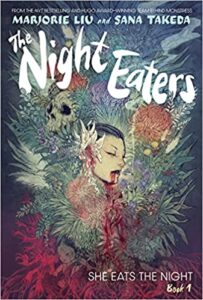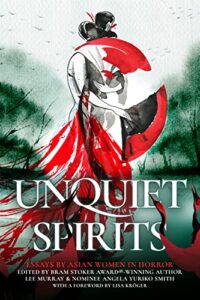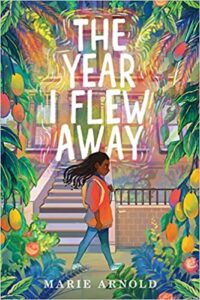The Night Eaters: Volume 1, She Eats the Night by Marjorie Liu and Sana Takeda
Abrams Comicarts, 2022
ISBN-13: 9781787739666
Available: Hardcover, paperback, Kindle edition, ( Bookshop.org | Amazon.com )
The creative team behind the Monstress comic series have created another world for readers to visit in The Night Eaters: She Eats the Night, the first in a trilogy.
Chinese-American twins Milly and Billy are in their early 20s and own their own business. They struggle to keep their restaurant afloat while navigating COVID-19. They also struggle with personal relationships and life in general. Billy spends his free time locked away killing virtual monsters, while Milly comes to terms with dropping out of med school and pining for her ex-boyfriend, who she still visits. Their parents, emotionally distant mother Ipo and laid-back father Keon, are in town for their annual visit. Ipo and Keon, immigrants from Hong Kong, have supported their children throughout their lives, but the parents worry that their support has hindered rather than helped their children.
To test their strength and fortitude, Ipo forces Billy and Milly to help her clean the house across the street, which was the scene of a grisly murder, and where dolls move on their own. Ipo has been hiding a deadly secret from them their entire lives. In the span of one night, everything is revealed to the twins, but they are left with more questions than answers.
Liu’s storytelling is great. The family dynamic is well-written, with tension, love, and humor, and the four of them are just dealing with each other at the forefront of the story. Milly and Billy have a believable sibling relationship, with antagonistic details on display. We get glimpses of Ipo and Keon’s relationship told in a series of flashbacks. We gradually find out more about them as a couple, as well as who they really are as people. Ipo spends more time with her plants than she does with her children, something which infuriates Milly. Keon is at times insufferably relaxed about situations that would send others into a panic or downright anger. Yet, they work as a couple, and their children are stronger than they are given credit for, especially by Ipo.
Takeda’s artwork is something I have sought out since I started reading Monstress. Her comic panels are beautiful. There are a few illustrations that feel like they were rushed, but her skill is still evident. Liu and Takeda give us another beautifully haunting, and haunted, in The Night Eaters: She Eats the Night. The next volume will be released in 2023. Highly recommended.
Reviewed by Lizzy Walker







Follow Us!